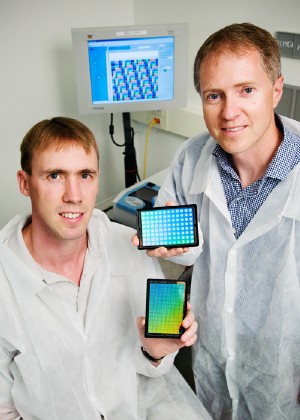Sep 24 2008
Scientists at the University of Illinois have developed a new class of disposable, microplate-based optical biosensors capable of detecting protein-DNA interactions. Based on the properties of photonic crystals, the biosensors are suitable for the rapid identification of inhibitors of protein-nucleic acid and protein-protein interactions.
 Paul Hergenrother, left, professor of chemistry, and Brian Cunningham, professor of electrical and computer engineering, hold biosensors they've developed that are capable of detecting protein-DNA interactions. Photo by L. Brian Stauffer
Paul Hergenrother, left, professor of chemistry, and Brian Cunningham, professor of electrical and computer engineering, hold biosensors they've developed that are capable of detecting protein-DNA interactions. Photo by L. Brian Stauffer
"Protein-DNA interactions are essential for fundamental cellular processes such as transcription, DNA damage repair and apoptosis," said Paul Hergenrother, a professor of chemistry and an affiliate of the university's Institute for Genomic Biology. "Screening for compounds that inhibit particular kinds of protein-DNA binding is a very important step in drug development."
Developed by Brian Cunningham, a U. of I. professor of electrical and computer engineering, the photonic crystal biosensors consist of a low-refractive-index polymer grating coated with a film of high-refractive-index titanium oxide, attached to the bottom of a standard 384-well microplate. Each well functions as a tiny test tube with a biosensor in the bottom.
"First, we selectively attach a biomolecule, such as DNA, to the bottom of each well. Then we see how that biomolecule interacts with other molecules, including drugs," said Cunningham, who also is affiliated with the university's Beckman Institute, Micro and Nanotechnology Laboratory, and Institute for Genomic Biology.
By examining the light reflected from the photonic crystal, the researchers can tell when molecules are added to, or removed from, the crystal surface. The measurement technique can be used, for example, in a high-throughput screening mode to rapidly identify molecules and compounds that prevent DNA-protein binding.
The researchers demonstrated the new technology by examining two very different protein-DNA interactions. The first was the bacterial toxin-antitoxin system MazEF, which binds to DNA in a sequence-specific manner and is thought to be responsible for the maintenance of resistance-encoding plasmids in certain infectious bacteria. The second was the human apoptosis-inducing factor (AIF), a protein that binds to chromosomal DNA in a DNA-sequence-independent manner.
The photonic crystal biosensor technology was further utilized in a screen for inhibitors of the AIF-DNA interaction, and through this screen aurin tricarboxylic acid was identified as the first in vitro inhibitor of AIF.
"Aurin tricarboxylic acid displayed about 80 percent inhibition of AIF-DNA binding," Hergenrother said. "Aurin tricarboxylic acid was the only compound to exhibit significant inhibition out of approximately 1,000 compounds screened."
While the photonic crystal biosensor was demonstrated only for protein-DNA interactions, analogous experiments with protein-RNA interactions, and protein-protein interactions are also possible, Cunningham said. "We also could grow cancer cells on the photonic crystal surface, and see how different drugs affect cell growth."